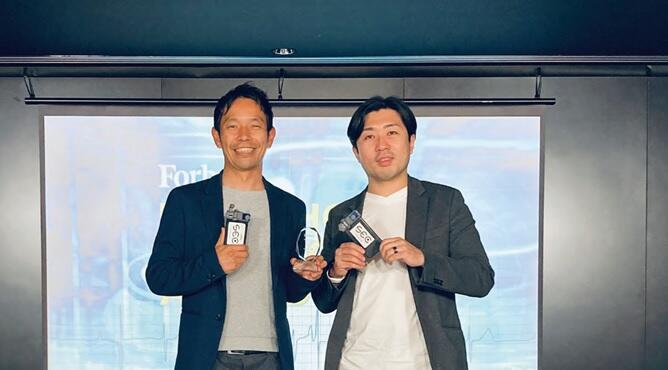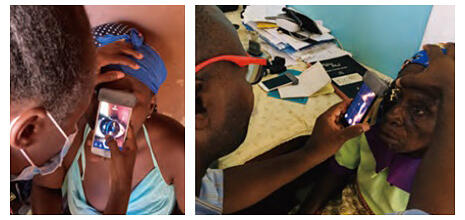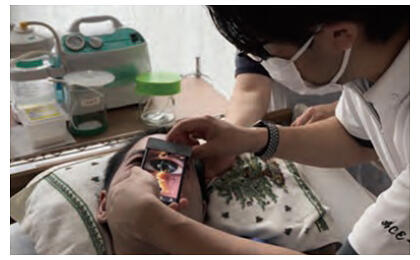In the segment 'A Look Around Innovation,' we introduce research and development (R&D) sites that have led to social implementation. In this 9th installment JST News visited OUI Inc., which has developed an ophthalmic medical device that can be easily attached to a smartphone, aiming to halve the number of blind people worldwide. The company is a venture originating from the Keio University School of Medicine and has begun preliminary projects in Asia, Africa, and Latin America.

Converting light-emitting diode (LED) light to slit light: A compact, lightweight, and robustly constructed device
By simply attaching a device to the camera lens, your smartphone can be used to observe your eyes under magnification and send image data to an ophthalmologist for remote diagnosis. Such a revolutionary attachment-type diagnostic medical device, "Smart Eye Camera (SEC)," was invented by Eisuke Shimizu, Chief Executive Officer of OUI Inc.
Shimizu is also an active ophthalmologist who graduated from Keio University School of Medicine. In 2017, he joined a volunteer clinic in a rural area of Vietnam as a member of an international medical cooperation project. There were only a limited number of ophthalmologists on site. Since no slit-lamp microscope, generally used in ophthalmology for diagnosis, was available, they had to use a penlight to shine a light on patient's eyes for diagnosis. During ophthalmic practice, Shimizu witnessed that many patients were suffering from visual disturbance and blindness due to inaccessibility to appropriate prevention and treatment of eye diseases such as cataracts. He wondered if the camera on a smartphone could be used for thorough eye examinations.
A slit-lamp microscope is an instrument that shines a slit light on the eye to observe its anterior segment, including the cornea and vitreous lens, under magnification. Shimizu thought to develop an attachment that converts LED light from a smartphone camera into slit light for use as an alternative to a slit-light microscope. With the help of an acquaintance, he produced a prototype with a 3D printer. He used it to observe actual eyes and confirmed that it could be used to diagnose anterior segment diseases. After improvements through clinical trials and other efforts, the SEC was completed in 2019.
The SEC is effective in diagnosing trachoma and conjunctivitis, Blepharitis, as well as anterior segment diseases such as cataracts and keratitis. Dry eyes can also be diagnosed using blue diffuse light as the light source (Figure 1). The SEC does not require a power supply and is compact, lightweight, and robustly constructed. Since it is simply attached to a smartphone, image data can be easily acquired by medical professionals other than ophthalmologists. "Since smartphones are widely used even in developing countries, we thought that many people who previously had no access to an ophthalmologist would get access to medical care," Shimizu explained.
Figure 1:Slit-lamp microscope, Smart Eye Camera (SEC), example of captured image

Selected for multiple projects, including AMED grants: Utilized by medical institutions in 40 countries
Shimizu and his colleagues commercialized the SEC through OUI Inc., which was started as a university-originated venture with the mission of "overcoming 50% of world blindness and protecting people's health with a focus on eyes." "There are approximately 2.2 billion people with sight disability and 43 million blind people in the world. More than half of blind people could have avoided blindness with proper prevention and treatment. To deliver eye care to medically underserved areas, creating a medical care model based on the local medical environment in conjunction with the SEC is important," said Nakayama.
OUI Inc. has been conducting pilot projects in Vietnam and other Southeast Asian and African countries with support from AMED in Japan, the International Finance Corporation, the Japan International Cooperation Agency, and other collaborators (Figure 2). Although traveling was restricted due to COVID-19, they conducted pilot projects such as online interviews with and observation of medical examinations by ophthalmologists, nurses, and other medical professionals in cooperation with medical institutions and other organizations in the aforementioned countries. They also visited countries where they could travel with required anti-COVID-19 measures and verified the pilot results. In parallel, the company also invested efforts to build evidence and sales networks in collaboration with local ophthalmologists.
Figure 2:Example of use in the African region

They visited Kenya, Mozambique, Malawi, Cambodia, Indonesia, and other countries for demonstrations during the pandemic. For example, only 14 ophthalmologists practice in Malawi, which has a population of about 18 million. Discussions were held with local partners on how to establish remote medical care in such a difficult environment. Thanks to the efforts of Nakayama and his colleagues, the SEC is already being used at medical institutions in 40 countries around the world. In the future, the company will consider local SEC production to promote its widespread use in these countries.
In use for home visit medical care in Japan — AI-assisted functions are also being considered
In 2023, the company was awarded the Minister of Education, Culture, Sports, Science and Technology Prize in the "STI for SDGs" awards (sponsored by JST), which recognize efforts to solve social issues through science, technology, and innovation and contribute to the achievement of the sustainable development goals (SDGs). Nakayama spoke about the company's vision: "I am very happy to receive this prestigious award. We are confident that our technology can contribute to solving problems in eye care around the world, and we hope to work together with our partners to expand our activities to reduce global blindness."
Even in urban areas of developed countries, various eye diseases such as myopia and dry eye are becoming more serious, and ensuring quality of life is becoming a major social issue. In particular, age-related eye diseases are on the rise in Japan's hyper-aged population, and certain people, such as bedridden elderly people, have difficulty accessing ophthalmic care even in urban areas. The SEC would allow a non-ophthalmologist to capture ophthalmic images of a patient during a home visit and consult with an ophthalmologist remotely. In fact, about half of the SEC devices sold in Japan are used by home care physicians (Figure 3).
Figure 3:Example of use in Japan

For some patients, such as those on remote islands, access to eye care can be difficult due to geographical barriers. In a recent case, a patient referred by a paramedic living on Chichi-jima Island was diagnosed remotely via the SEC and was successfully referred to a specialist for treatment. Moreover, Nakayama said that the company has a future plan to incorporate the SEC-based diagnosis into various preventive efforts, such as health checkups for company employees, residents, and school students and complete medical checkups. "We are developing a direct ophthalmoscope model and fundus camera model that can observe deep into the eyeball to enable diagnosis of glaucoma, chorioretinal atrophy, age-related macular degeneration, and other conditions," said Shimizu enthusiastically.
Recently, the company has also been developing an AI that can use image data accumulated through the SEC to analyze the severity of cataracts and other purposes. Development is underway in consultation with local medical institutions to introduce this technology into clinical practice so that appropriate diagnosis and treatment are accessible more easily and efficiently. OUI Inc. is promoting its business as a Japan-originated technology in partnership with medical institutions, non-profit organizations, non-governmental organizations, and international cooperation organizations in various countries. Their activities to deliver the "eyes" of ophthalmologists to the world will continue.
(Article: Shinji Moribe, Photography: OUI Inc.)




